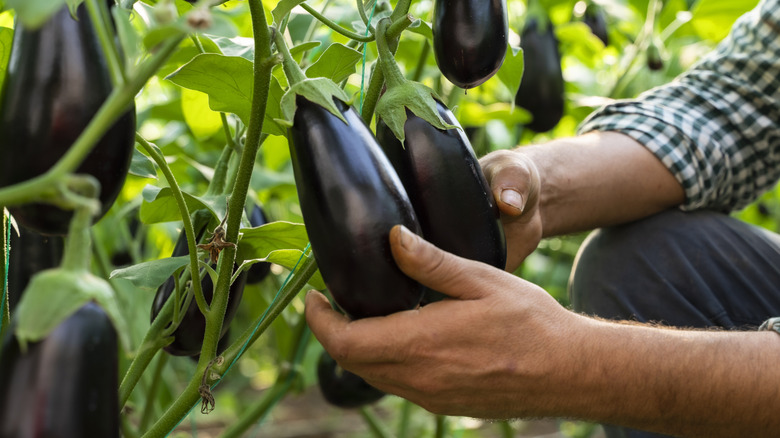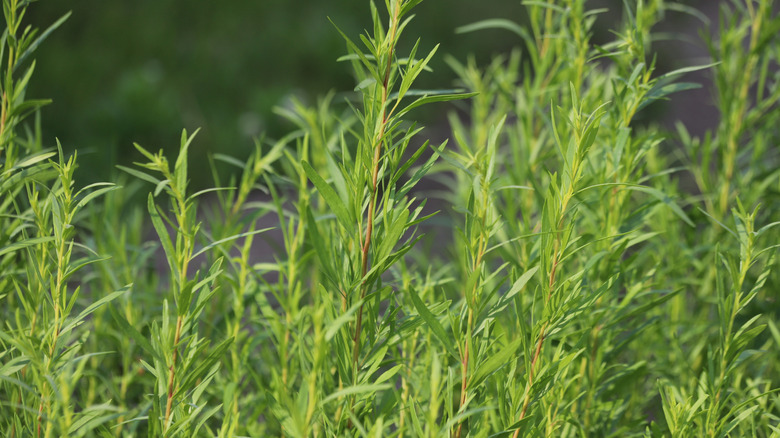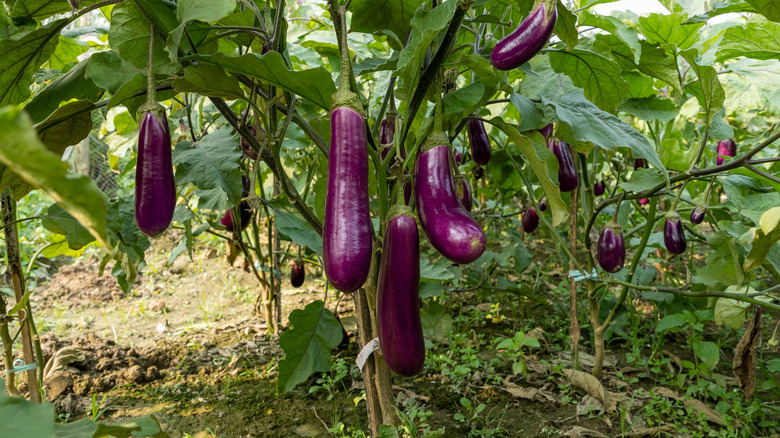The Delicious Herb That'll Help The Eggplant In Your Vegetable Garden Thrive
Unmistakable in the garden and versatile in the kitchen, eggplant (Solanum melongena) is a staple of cuisines across the world. The sun-loving vegetable grows vigorously, producing batches of rounded purple, white, or striped fruits that can be cooked and flavored in many ways. But in the home garden, this colorful member of the Solanaceae, or nightshade, family can easily fall victim to pests like flea beetles. Instead of using harsh chemicals, you can reap the benefits of companion planting in the garden by adding French tarragon (Artemisia dracunculus 'Sativa') near your eggplant. Much more than just a delicious herb, French tarragon can help your eggplant thrive by repelling flea beetles — and enhancing your harvest's flavor in the process.
Not to be confused with Russian tarragon or wild tarragon, which are much less tasty, French tarragon is an aromatic culinary herb that resembles rosemary but has a spicy-sweet anise scent. Native to temperate regions of Europe and Asia near the Caspian Sea, this tarragon is a hallmark of French cuisine. One of its most common uses is to flavor béarnaise sauce, but it's also a vital ingredient in popular herb mixes such as herbes de Provence. When it comes to the garden, though, its scent is its superpower. And once you learn how to grow this hardy, flavorsome herb in your garden, you'll benefit from the perennial powerhouse each year.
French tarragon's scent keeps insects at bay
With a nickname like "Herbe au Dragon," it's no surprise French tarragon is known for having a bit of a bite. Even the botanical species name, dracunculus, meaning little dragon in Latin, gives a nod to this herb's fiery flavor. But where the human nose is allured, insects are sharply deterred. French tarragon may have won the hearts of chefs the world over (it's even sometimes called the "King of Herbs"), but bugs despise its strong scent. Filling your garden with this fragrance can help protect your eggplant from insects like flea beetles, which damage plants by chewing small holes in their leaves. These pests can be particularly devastating to small seedlings, making French tarragon's early growth a lifeline for your youngest plants.
As a cool-weather perennial, French tarragon is one of the first plants to break dormancy in early spring. It quickly returns to its leafy nature, and with proper pruning, will begin to form a small bush before your eggplant is even ready to transplant. This staggered growth cycle means your French tarragon will already be repelling pests from the area as your other plants become established, protecting your eggplants at their most vulnerable stage. But French tarragon's help doesn't stop there; this spicy herb is also said to enhance the flavor of vegetables, especially eggplant.
How to grow eggplant and French tarragon together
Eggplant and French tarragon also make great companion plants because they enjoy many of the same growing conditions. And where their preferences differ, the two complement each other nicely, making it easy for both plants to thrive. French tarragon, hardy and perennial in USDA Hardiness Zones 5 to 8, flourishes in soil with the same neutral pH as eggplant (which is usually grown as an annual). Both require a well-draining medium and lots of sun, although French tarragon's delicate foliage may wilt in direct light on a hot afternoon. But since eggplant is a perfect plant to use with a trellis, you can train your eggplant into a shady canopy for your French tarragon.
Like tomatoes and other members of the nightshade family, eggplants prefer consistent moisture in order to produce plump, healthy fruit. But they are also more drought-tolerant than most other vegetables and require infrequent, deep waterings. You won't have to worry about your French tarragon suffering in these conditions either. This drought-tolerant species thrives when the soil dries out between waterings — it may even enhance the herb's sharp, spicy flavor. And since eggplant and French tarragon pair just as well on a plate as they do in the garden, you can harvest them together for a home-cooked meal.


